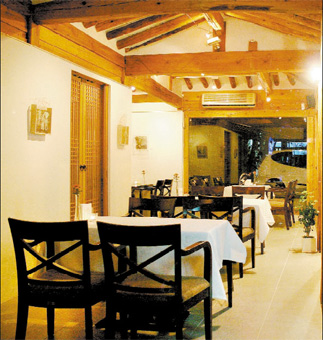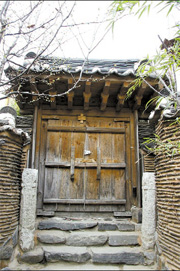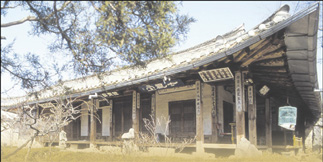Harmonious home made of wood and light

Above: The Rakkojae lodge in a hanok in Gye-dong, Seoul. By Kim Han-byul

Gallery You, a wine bar and restaurant in a hanok in Sagan-dong. [JoongAng Ilbo]
Traditional Korean homes, or hanok, in Bukchon were the victims of mass destruction in the late ’90s, as redevelopment swept the area and homeowners bulldozed aging structures to erect modern homes equipped with convenient utilities.
Now hanok are making a comeback. They are suddenly seen as chic. Individuals and commercial enterprise are clamoring for a hanok of their own.
“There is a growing interest in hanok, especially after the Seoul city government started offering financial incentives to those who renovate them,” said Hwang Du-jin, an architect and the author of “The Return of Hanok.”
Hwang believes the concentration of hanok in Bukchon, situated between Gyeongbok and Changdeok palaces, adds exquisite beauty to the area.

A gate at the Rakkojae By Kim Han-byul.
“The beauty of hanok lies in its openness and harmony with its environment,” Hwang said. “There is less distinction between in and outdoors than there is with a modern house.”
The openness and spaciousness of a hanok comes from the fact that a large percentage of its wall space is occupied by windows. In her book “The Making of Hanok by Arumjigi,” Jeong Min-ja wrote, “Without windows and doors, it is no exaggeration to say that a hanok is nothing but pillars.”
Opening the doors of the main bedroom leads to the spacious floor, or maru, of the roofed main hall. The maru is often located between two rooms, the main bedroom and another smaller bedroom. One side of the hall is completely open while the other side, again, has large doors. With the two sides being open, free air flows and keeps the floor of the main hall cool in the summer.
Byun Sook-hyun, the principal of Hanok School in Cheongdo county, North Gyeongsang province, said the beauty of hanok comes from the roofline, with its exposed wooden frames. Wherever one stands in a hanok, one can see the roof structure, which consists of the rafters, angle rafters and crossbeams. The rafters and crossbeams are assembled together on their grooves and placed on top of each other to form the triangular roof. To many people’s surprise, no nails or glue are used to build the roof; instead the roof and the pillars sustaining it strike a perfect balance. The eaves, which are at the far end of the rafters, hang over the walls and run around the house.
According to Byun, the roof, in addition to its beauty, has many scientific advantages.

A general hanok structural plan.
The gudeul, the underfloor heating system (also known as ondol), keeps the house warm while the air flow in the main hall provides relief from the summer heat. Gudeul came from the north, while maru was devised in the south. “It is amazing that hanok has gudeul for winter and maru for summer, all at the same time,” Byun said.
One of the biggest differences between a hanok and a modern house is that a hanok is almost entirely made of wood. “First of all, the feel from different types of wood makes a huge difference,” Hwang said.
Using wood has many benefits, even today. Wood is usually free of harmful materials. Sick house syndrome, caused by using artificial construction materials, has brought attention to the benefits of using wood when building a house.
Being made of wood, a hanok also conveys the feeling that it is a living structure. According to Jeong, wooden houses move due to changes in temperature. Woods expand in warm weather while they shrink when it’s cold.
However, there are disadvantages with using wood. An environment good for humans is also good for insects and mold. And using wood can make it difficult to build a house with several stories.
There are also structural problems with hanok. A large amount of soil is piled upon the roof, to fix the tiles in place. According to Hwang, there is no other Asian culture that uses soil on the roof. The soil on the roof keeps it moist, but it also causes decay in the wood.
Hanok were the bedrock of Korean lifestyles for many years. The arrangement of the rooms in relation to the family members who live in them is closely connected to Confucian culture. A large house often has a sarangchae and an anchae. The sarangchae is a building close to the main gate, and there was often a library. It was occupied by the father and the eldest son, who trained with his father so that, one day, he too could become head of his own family. The building was also used to welcome important guests and hold ceremonies to pay tribute to ancestors. Anchae, located deeper inside the house, were used by the mother and the daughter-in-law. They also have kitchens.
Seoul city put strict limits on renovating hanok in 1984, but due to mounting anger among homeowners, the city revised the ban in 1991, and again in 1994. The residents, unhappy with the aging homes, either sold them or built new, modern houses instead. The number of hanok in the city dropped from 1,518 in 1985 to 947 in 2000. In 2001, in a move to preserve hanok, Seoul city began covering two-thirds of a homeowner’s renovation costs, up to 30 million won ($32,000), or 60 million won if the homeowner was willing to open their house to the public.
Among the benefactors of these generous incentives was Ahn Young-hwan, a Korean-American entrepreneur who owns Rakkojae (www.rkj.co.kr), a lodge in a hanok in Gye-dong, Jongno district. The 70-year-old main building in the lodge is a historic structure used by Jindan Hakhoe, a group of scholars who resisted Japanese colonialism by studying Korean history and traditions in 1934. Ahn bought the building in 2003 and renovated it so that it is now a modern, convenient facility.
“I wanted to raise awareness about Korean culture,” Ahn said. “A country or an ethnic group is judged on their culture and I felt that Westerners lacked understanding of Korean culture.”
The renovation, however, was more difficult than he anticipated, because the rafters sustaining the roof were decaying. Only one-fifth of the original materials were saved. Ahn said the renovation cost more than the price of the land and the house.
Yoo Moon-hwa, the proprietor of Gallery You (www.yougallery.co.kr), refurbished a hanok and turned it into a wine bar and Italian restaurant four years ago. The century-old house was the home of a court lady during the Joseon dynasty, she said. The popularity of hanok among individuals and restaurant owners in the area in recent years comes because hanok convey a sense of comfort and tranquility that is perfect for lodging or eating.
“People live and work in standardized concrete buildings and it is suffocating. But hanok make people feel comfortable and secure,” said Yoo.
The most difficult part of remodeling the house was to find a balance between the traditional and the contemporary, to suit the food served in the restaurant. Restaurants in hanok typically serve Korean beef rib barbecue or traditional Korean course meals, but Yoo broke away from the stereotype and opened an Italian restaurant. That made her task more complex.
A number of small but trendy restaurants in Bukchon such as Dugaheon (3210-2100), Recipe (736-7301), Okitchen (744-6420) and Ca’ Del Lupo (734-5233) opened in hanok, and wealthy businessmen having been buying them to remodel. This interest in hanok has pushed up their price. In the last five years, it has almost tripled to 3 million won per square meter (10 square feet).
However, the recent popularity of hanok does not mean that they are going to become mainstream housing again.

The cost of building a hanok is one-and-half times, or even twice as expensive as building a modern house. “For now, owning a hanok is possible for a limited number of people and that isn’t normal,” said Hwang. “It must be made available to a broader range of the population. The tradition continues most strongly when the general public participates.”
For that purpose, construction materials need to be standardized so that the cost is lowered, Hwang said.
“Building hanok needs to be industrialized so that companies can mass produce wooden materials and components,” he said.
By Limb Jae-un Staff Writer [jbiz91@joongang.co.kr]










with the Korea JoongAng Daily
To write comments, please log in to one of the accounts.
Standards Board Policy (0/250자)